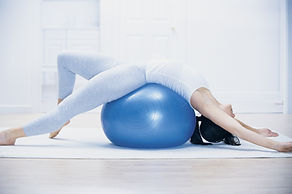Pilates for Kyphosis
Kyphosis is a forward rounding of the back. Some rounding is normal, but the term "kyphosis" usually refers to an exaggerated rounding of the back. While kyphosis can occur at any age, it's most common in older women.
Age-related kyphosis often occurs after osteoporosis weakens spinal bones to the point that they crack and compress.
Other types of kyphosis are seen in infants or teens due to malformation of the spine or wedging of the spinal bones over time.
Mild kyphosis causes few problems, but severe cases can cause pain and be disfiguring. Treatment for kyphosis depends on your age, the cause of the curvature and its effects.
Symptoms
In addition to an abnormally curved spine, kyphosis can also cause back pain and stiffness in some people. Mild cases of kyphosis may produce no noticeable signs or symptoms.
When to see a doctor
Make an appointment with your doctor if you notice an increased curve in your upper back or in your child's spine.
Causes
The individual bones (vertebrae) that make up a healthy spine look like cylinders stacked in a column. Kyphosis occurs when the vertebrae in the upper back become more wedge-shaped. This deformity can be caused by a variety of problems, including:
-
Osteoporosis. This bone-thinning disorder can result in crushed vertebrae (compression fractures). Osteoporosis is most common in older adults, particularly women, and in people who have taken high doses of corticosteroids for long periods of time.
-
Disk degeneration. Soft, circular disks act as cushions between spinal vertebrae. With age, these disks dry out and shrink, which often worsens kyphosis.
-
Scheuermann's disease. Also called Scheuermann's kyphosis, this disease typically begins during the growth spurt that occurs before puberty. Boys are affected more often than are girls. The rounding of the back may worsen as the child finishes growing.
-
Birth defects. If a baby's spinal column doesn't develop properly in the womb, the spinal bones may not form properly, causing kyphosis.
-
Syndromes. Kyphosis in children can also be associated with certain syndromes, such as Marfan syndrome or Prader-Willi disease.
-
Cancer and cancer treatments. Cancer in the spine can weaken vertebrae and make them more prone to compression fractures, as can chemotherapy and radiation cancer treatments.
An increased curve in the upper spine also can be caused by slouching. Called postural kyphosis, this condition doesn't involve any deformities in the spine. It's most common in teenagers.
Complications
Kyphosis may cause the following complications:
-
Body image problems. Adolescents especially may develop a poor body image from having a rounded back or from wearing a brace to correct the condition.
-
Back pain. In some cases, the misalignment of the spine can lead to pain, which can become severe and disabling.
-
Decreased appetite. In severe cases, the curve may cause the abdomen to be compressed and lead to decreased appetite.
Treatments and drugs
Kyphosis treatment depends on the cause of the condition and the signs and symptoms that are present.
Medications
Your doctor may suggest:
-
Pain relievers. If over-the-counter medicines — such as acetaminophen (Tylenol, others), ibuprofen (Advil, Motrin IB, others) or naproxen (Aleve) — aren't enough, stronger pain medications are available by prescription.
-
Osteoporosis drugs. In many older people, kyphosis is the first clue that they have osteoporosis. Bone-strengthening drugs may help prevent additional spinal fractures that would cause your kyphosis to worsen.
Therapy
Some types of kyphosis can be helped by:
-
Exercises. Stretching exercises can improve spinal flexibility and relieve back pain. Exercises that strengthen the abdominal muscles may help improve posture.
-
Bracing. Children who have Scheuermann's disease may be able to stop the progression of kyphosis by wearing a body brace while their bones are still growing.
-
Healthy lifestyle. Maintaining a healthy body weight and regular physical activity will help prevent back pain and relieve back symptoms from kyphosis.
-
Maintaining good bone density. Proper diet with calcium and vitamin D and screening for low bone density, particularly if there is a family history of osteoporosis or history of previous fracture, may help older adults avoid weak bones, compression fractures and subsequent kyphosis.
Surgical and other procedures
If the kyphosis curve is very severe or if the curve is pinching the spinal cord or nerve roots, your doctor might suggest surgery to reduce the degree of curvature.
The most common procedure, called spinal fusion, connects two or more of the affected vertebrae permanently. Surgeons insert pieces of bone between the vertebrae and then fasten the vertebrae together with metal rods and screws until the spine heals together in a corrected position.
The above article is from
http://www.mayoclinic.org/diseases-conditions/kyphosis/basics/treatment/con-20026732
Pilates is all about moving efficiently. What makes Pilates so important with respect to posture is that Pilates trains us to develop and use core strength, rather than holding our position with superficial musculature.
Using the deep core muscles of the powerhouse - the abdominals, back, and pelvic floor - to support our posture allows the shoulders to relax, the neck and head to move freely, and relieves stress on the hips, legs, and feet.
Pilates for better posture
Benefits of Good Posture:
pain relief throughout the body, including back and neck pain, hip pain, leg and foot pain.
allows us to move efficiently
improves muscle function
increases range of motion
takes pressure off of compressed organs
improves circulation
creates a trimmer appearance
radiates an attitude of confidence
If you’re imbalanced in your body, that means some of your muscles are compensating for other muscles, and eventually the guys doing all of the work are going to quit.
Pilates can teach you how to align your spine.
For further information, please do not hesitate in contact me.



